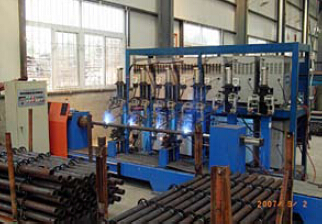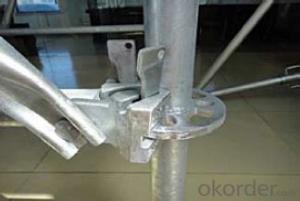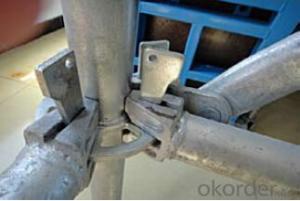Ring-lock Scaffolding Accessories for scaffolding system
- Loading Port:
- Tianjin
- Payment Terms:
- TT OR LC
- Min Order Qty:
- 50 m²
- Supply Capability:
- 1000 m²/month
OKorder Service Pledge
Quality Product, Order Online Tracking, Timely Delivery
OKorder Financial Service
Credit Rating, Credit Services, Credit Purchasing
You Might Also Like
Ring-lock Scaffolding
A support system for construction, ownsadvantages of both cup-lock scaffolding andshoring tower.
It is in the development direction of new typescaffolding.
It is widely used in buildings, bridges, tunnels etc..
Characteristics:
◆ Easy to storage and transportation
◆ High degree of standardization
◆ Easy and quick erection
◆ Excellent stability and bearing capacity


- Q:Can steel formwork be used for post-tensioned concrete structures?
- Yes, steel formwork can be used for post-tensioned concrete structures. Steel formwork is a versatile and durable material that can withstand the forces generated during the post-tensioning process. It provides a rigid and stable support for the concrete to be poured and allows for accurate shaping and positioning of the post-tensioned tendons. Steel formwork offers several advantages for post-tensioned concrete structures. Firstly, it helps in achieving the desired shape and dimensions of the structure by providing a strong and rigid framework. This is crucial for post-tensioned structures as the internal forces generated by the tendons can put significant pressure on the formwork. Secondly, steel formwork allows for easy and efficient installation of the post-tensioned tendons. The formwork can be designed with specific features to accommodate the tendons and their anchorages, ensuring proper placement and alignment. This is important as the tendons need to be accurately positioned to achieve the desired structural performance. Additionally, steel formwork offers good reusability and durability. It can withstand multiple pourings of concrete and can be easily dismantled and reassembled for future use. This makes it a cost-effective choice for post-tensioned concrete structures, especially for projects with repetitive elements. However, it is important to note that the design and construction of steel formwork for post-tensioned concrete structures should be carried out by experienced professionals. This ensures that the formwork can withstand the forces generated during the post-tensioning process and provides the necessary support and alignment for the tendons. Adequate consideration should also be given to factors such as formwork strength, rigidity, and anchorage points to ensure a successful post-tensioning operation. Overall, steel formwork can indeed be used for post-tensioned concrete structures, provided it is designed and constructed appropriately to handle the specific requirements of the project.
- Q:What are the common safety measures to be followed when using steel formwork?
- To ensure the safety of workers and the successful completion of construction projects using steel formwork, it is important to adhere to several safety measures. These measures include: 1. Proper training and education: All workers involved in the use of steel formwork should receive comprehensive training on its installation, usage, and dismantling. They must be knowledgeable about potential hazards and how to mitigate them. 2. Inspection and maintenance: Before utilizing steel formwork, it is crucial to thoroughly inspect it for any defects or damages. Any issues should be promptly addressed or the formwork should be replaced. Regular maintenance should also be performed to ensure its structural integrity. 3. Careful handling and storage: Steel formwork should be handled with caution to avoid injuries. It should be stored in a designated area, away from potential hazards or heavy machinery. 4. Use of personal protective equipment (PPE): To safeguard themselves from potential hazards or falling objects, workers should always wear appropriate PPE, such as safety helmets, safety goggles, gloves, and safety shoes. 5. Sufficient bracing and support: To prevent collapse or structural failure, steel formwork should be adequately braced and supported. This involves using the correct number and type of props or supports, as well as ensuring the formwork is level and plumb. 6. Secure and stable footing: Workers must have a secure and stable footing when working with steel formwork. This may necessitate the use of scaffolding or temporary platforms to provide a safe working surface. 7. Proper lifting techniques: When lifting or moving steel formwork, workers should employ correct lifting techniques to prevent strains or injuries. This may entail using lifting equipment, such as cranes or hoists, and ensuring an even distribution of the load. 8. Effective communication and coordination: Clear communication and coordination among workers is essential when utilizing steel formwork. This helps prevent accidents and ensures that everyone understands their roles and responsibilities. By adhering to these common safety measures, the risk of accidents or injuries when using steel formwork can be significantly reduced, resulting in a safer and more productive work environment.
- Q:How does steel formwork impact the overall project budgeting?
- The overall project budgeting can be significantly affected by steel formwork. Although the initial cost of steel formwork may be higher compared to wood or plastic formwork, it offers several advantages that can help offset the initial investment. To begin with, steel formwork is renowned for its durability and longevity. Unlike wood or plastic formwork, steel formwork can be reused multiple times without compromising its structural integrity. This reusability factor reduces the need for frequent replacement or repair, resulting in long-term cost savings. Furthermore, steel formwork provides a superior finish to concrete structures. The smooth and even finish achieved with steel formwork minimizes the need for additional surface treatments or finishing work, leading to cost savings. Moreover, steel formwork offers increased strength and stability, enabling the construction of larger and more complex structures. This eliminates the necessity for additional support systems or reinforcements, which can be costly and time-consuming. Additionally, steel formwork is easy to assemble and dismantle, resulting in faster construction times. The quick turnaround time reduces labor costs and allows for earlier project completion, which is particularly advantageous for time-sensitive projects. Lastly, steel formwork is resistant to adverse weather conditions, such as moisture or extreme temperatures, which can negatively impact the effectiveness and lifespan of the formwork. This resistance reduces the risk of formwork damage and replacement costs, contributing to cost savings. In conclusion, while steel formwork may have a higher upfront cost, its durability, reusability, high-quality finish, strength, ease of use, and resistance to weather conditions can all contribute to cost savings in terms of reduced labor, material, and maintenance expenses. Therefore, steel formwork can positively impact the overall project budgeting.
- Q:Can steel formwork be used for curved walls?
- Yes, steel formwork can be used for curved walls. Steel formwork is highly versatile and can be easily shaped and adjusted to create curved walls of various sizes and angles. Its strength and durability make it suitable for the unique demands of curved wall construction.
- Q:What are the advantages of using modular steel formwork systems?
- There are several advantages of using modular steel formwork systems. Firstly, these systems are highly durable and can be reused multiple times, leading to cost savings in the long run. Secondly, they provide accurate and precise results, ensuring consistency in construction projects. Additionally, modular steel formwork systems offer flexibility and can be easily adjusted or customized to meet specific project requirements. They also enhance productivity as they can be quickly assembled and disassembled, saving time and labor. Moreover, these systems provide a smooth and high-quality finish to concrete structures. Overall, the advantages of using modular steel formwork systems include durability, cost-effectiveness, accuracy, flexibility, productivity, and superior finish.
- Q:What types of concrete structures can be built using steel formwork?
- Steel formwork is a versatile construction tool that has the capability to build a variety of concrete structures. Some examples of common structures that can be created using steel formwork are: 1. Walls: Steel formwork can be utilized to construct both retaining walls and load-bearing walls. It provides the necessary support to hold the concrete in place until it sets and gains its strength. Steel formwork allows for the construction of walls with different shapes and sizes, such as straight, curved, or inclined walls. 2. Columns: For constructing columns of varying heights and diameters, steel formwork is the ideal choice. It offers a strong and stable framework to hold the concrete in place while it cures. Steel formwork can be easily adjusted to accommodate various column dimensions, making it suitable for both small and large-scale construction projects. 3. Beams and Slabs: Beams, which are horizontal structural members that support the structure above, and slabs, which form the floors or roofs of a building, can also be constructed using steel formwork. Steel formwork allows for the construction of beams and slabs with different shapes and sizes, including rectangular, circular, or even curved configurations. 4. Bridges and Tunnels: Bridges and tunnels commonly rely on steel formwork during construction. It enables the creation of complex structural elements with high precision and accuracy. Steel formwork systems are easily transportable and can be assembled on-site, making them an efficient choice for bridge and tunnel construction projects. 5. Staircases: Steel formwork can also be used to build staircases with various configurations, such as straight flights, spiral stairs, or helical stairs. It provides the necessary support to create the desired shape and geometry of the staircase. Steel formwork ensures the structural integrity of the staircase while the concrete sets and hardens. In summary, steel formwork is a flexible and durable solution for constructing a wide range of concrete structures. Its adaptability, strength, and ease of use make it an ideal choice for various construction projects, including residential buildings and large-scale infrastructure developments.
- Q:How does steel formwork affect the overall timeline of a construction project?
- Steel formwork can significantly reduce the overall timeline of a construction project. Unlike traditional timber formwork, steel formwork is more durable and can be reused multiple times, resulting in faster assembly and disassembly. Its strength and rigidity allow for faster pouring and curing of concrete, reducing the time required for each construction phase. Additionally, steel formwork requires less maintenance and is less susceptible to warping or shrinking, ensuring a smooth and efficient construction process.
- Q:What type of concrete finishes can be achieved with steel formwork?
- Steel formwork offers a multitude of possibilities for achieving various concrete finishes. A popular choice is a smooth and level surface, which can be accomplished by using steel formwork with a sleek texture. This finish is well-suited for areas that necessitate an even and flat surface, such as floors and walls. Another option is to achieve a textured or patterned surface using steel formwork. This can be done by utilizing formwork with a textured or patterned surface itself, or by incorporating additional materials like rubber or plastic liners to create the desired texture or pattern. This finish is often employed for decorative purposes, such as architectural concrete elements or exposed aggregate finishes. Furthermore, steel formwork allows for the creation of curved or shaped concrete surfaces. This involves bending or shaping the formwork prior to pouring the concrete, resulting in unique and visually pleasing shapes. This type of finish is commonly used in architectural or artistic applications. Ultimately, steel formwork provides a versatile solution for achieving a diverse range of concrete finishes, including smooth, textured, patterned, and curved surfaces. The choice of finish depends on the specific requirements and desired aesthetics of the project.
- Q:What are the common safety guidelines when working with steel formwork in hazardous areas?
- When working with steel formwork in hazardous areas, it is important to follow some common safety guidelines. These include wearing appropriate personal protective equipment (PPE) such as safety goggles, gloves, and steel-toed boots to protect against potential hazards. Additionally, workers should ensure that the steel formwork is properly installed and secured to prevent any accidents or collapses. It is also essential to be aware of the weight and load capacity of the formwork to avoid overloading and potential structural failures. Regular inspections and maintenance of the formwork are necessary to identify any defects or weaknesses that could compromise safety. Lastly, workers should be trained on emergency procedures and know the location of emergency exits and evacuation routes in case of any unforeseen incidents.
- Q:How does steel formwork affect the overall thermal performance of the building?
- Steel formwork does not directly affect the overall thermal performance of the building as it is primarily used in the construction process for shaping and supporting concrete structures. However, if steel formwork is not properly insulated or if there are gaps between the formwork and the concrete, it can contribute to thermal bridging, which can negatively impact the building's energy efficiency.
1. Manufacturer Overview |
|
|---|---|
| Location | |
| Year Established | |
| Annual Output Value | |
| Main Markets | |
| Company Certifications | |
2. Manufacturer Certificates |
|
|---|---|
| a) Certification Name | |
| Range | |
| Reference | |
| Validity Period | |
3. Manufacturer Capability |
|
|---|---|
| a)Trade Capacity | |
| Nearest Port | |
| Export Percentage | |
| No.of Employees in Trade Department | |
| Language Spoken: | |
| b)Factory Information | |
| Factory Size: | |
| No. of Production Lines | |
| Contract Manufacturing | |
| Product Price Range | |
Send your message to us
Ring-lock Scaffolding Accessories for scaffolding system
- Loading Port:
- Tianjin
- Payment Terms:
- TT OR LC
- Min Order Qty:
- 50 m²
- Supply Capability:
- 1000 m²/month
OKorder Service Pledge
Quality Product, Order Online Tracking, Timely Delivery
OKorder Financial Service
Credit Rating, Credit Services, Credit Purchasing
Similar products
New products
Hot products
Hot Searches
Related keywords

























